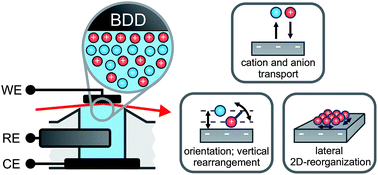当前位置:
X-MOL 学术
›
Faraday Discuss.
›
论文详情
Our official English website, www.x-mol.net, welcomes your feedback! (Note: you will need to create a separate account there.)
Molecular scale structure and dynamics at an ionic liquid/electrode interface
Faraday Discussions ( IF 3.4 ) Pub Date : 2017-06-27 00:00:00 , DOI: 10.1039/c7fd00171a Peter Reichert 1, 2, 3, 4, 5 , Kasper Skov Kjær 6, 7, 8, 9, 10 , Tim Brandt van Driel 6, 7, 8, 9, 10 , Julian Mars 1, 2, 3, 4, 5 , Jannis Walther Ochsmann 1, 2, 3 , Diego Pontoni 11, 12, 13 , Moshe Deutsch 7, 14, 15, 16, 17 , Martin Meedom Nielsen 6, 7, 8, 9, 10 , Markus Mezger 1, 2, 3, 4, 5
Faraday Discussions ( IF 3.4 ) Pub Date : 2017-06-27 00:00:00 , DOI: 10.1039/c7fd00171a Peter Reichert 1, 2, 3, 4, 5 , Kasper Skov Kjær 6, 7, 8, 9, 10 , Tim Brandt van Driel 6, 7, 8, 9, 10 , Julian Mars 1, 2, 3, 4, 5 , Jannis Walther Ochsmann 1, 2, 3 , Diego Pontoni 11, 12, 13 , Moshe Deutsch 7, 14, 15, 16, 17 , Martin Meedom Nielsen 6, 7, 8, 9, 10 , Markus Mezger 1, 2, 3, 4, 5
Affiliation

|
After a century of research, the potential-dependent ion distribution at electrode/electrolyte interfaces is still under debate. In particular for solvent-free electrolytes such as room-temperature ionic liquids, classical theories for the electrical double layer are not applicable. Using a combination of in situ high-energy X-ray reflectivity and impedance spectroscopy measurements, we determined this distribution with sub-molecular resolution. We find oscillatory charge density profiles consisting of alternating anion- and cation-enriched layers at both cathodic and anodic potentials. This structure is shown to arise from the same ion–ion correlations dominating the liquid bulk structure. The relaxation dynamics of the interfacial structure upon charging/discharging were studied by impedance spectroscopy and time resolved X-ray reflectivity experiments with sub-millisecond resolution. The analysis revealed three relaxation processes of vastly different characteristic time scales: a 2 ms scale interface-normal ion transport, a 100 ms scale molecular reorientation, and a minute scale lateral ordering within the first layer.
中文翻译:

离子液体/电极界面的分子尺度结构和动力学
经过一个世纪的研究,在电极/电解质界面上与电势有关的离子分布仍在争论中。特别是对于无溶剂的电解质,例如室温离子液体,双电层的经典理论是不适用的。使用原位组合通过高能X射线反射率和阻抗谱测量,我们确定了具有亚分子分辨率的这种分布。我们发现,在阴极和阳极电位处,由交替的富含阴离子和阳离子的富集层组成的振荡电荷密度分布。该结构证明是由相同的离子-离子相关性支配着液体本体结构而产生的。通过阻抗光谱和时间分辨的亚毫秒分辨率的X射线反射率实验研究了界面结构在充电/放电时的弛豫动力学。分析揭示了三种弛豫过程,这些弛豫过程的特征时间尺度差异很大:2毫秒尺度的界面-正常离子传输,100毫秒尺度的分子重新定向以及第一层内部的微小尺度横向排序。
更新日期:2017-12-15
中文翻译:

离子液体/电极界面的分子尺度结构和动力学
经过一个世纪的研究,在电极/电解质界面上与电势有关的离子分布仍在争论中。特别是对于无溶剂的电解质,例如室温离子液体,双电层的经典理论是不适用的。使用原位组合通过高能X射线反射率和阻抗谱测量,我们确定了具有亚分子分辨率的这种分布。我们发现,在阴极和阳极电位处,由交替的富含阴离子和阳离子的富集层组成的振荡电荷密度分布。该结构证明是由相同的离子-离子相关性支配着液体本体结构而产生的。通过阻抗光谱和时间分辨的亚毫秒分辨率的X射线反射率实验研究了界面结构在充电/放电时的弛豫动力学。分析揭示了三种弛豫过程,这些弛豫过程的特征时间尺度差异很大:2毫秒尺度的界面-正常离子传输,100毫秒尺度的分子重新定向以及第一层内部的微小尺度横向排序。


























 京公网安备 11010802027423号
京公网安备 11010802027423号